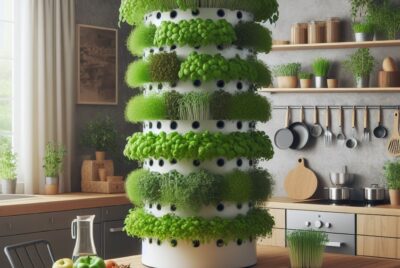Disadvantages of Microgreens: Unveiling the Downsides
I believe it’s essential to provide a balanced view of this popular food trend. While microgreens offer numerous benefits, it’s important to acknowledge their disadvantages as well. In this article, I will explore the disadvantages of microgreens and provide helpful suggestions for overcoming them.
Introduction
Microgreens have gained significant popularity in recent years due to their high nutrient content, vibrant colors, and unique flavors. These young and tender vegetable greens are harvested just a few weeks after germination, making them an excellent addition to salads, sandwiches, and various dishes. However, it’s crucial to be aware of the potential downsides associated with consuming microgreens.
What are Microgreens?
Before delving into the disadvantages, let’s briefly define what microgreens are. Microgreens are the edible seedlings of vegetables and herbs that are harvested when they have developed their first true leaves. These miniature greens are packed with concentrated nutrients and are often used as garnishes or added to dishes for their visual appeal and enhanced flavor.
Benefits of Microgreens
Microgreens offer an array of health benefits, including high levels of vitamins, minerals, and antioxidants. They are a convenient way to incorporate nutrient-dense foods into your diet, especially for those with limited access to fresh produce or limited gardening space. Additionally, microgreens can be grown indoors throughout the year, providing a continuous source of fresh greens.
Disadvantages of Microgreens
1. Limited Shelf Life: One of the main disadvantages of microgreens is their short shelf life. Due to their delicate nature, microgreens tend to wilt and spoil quickly compared to mature vegetables. This limited shelf life can pose challenges in terms of storage and transportation, especially for commercial growers and suppliers.
2. Risk of Contamination: Microgreens are grown in a moist and humid environment, which can make them susceptible to bacterial and fungal contamination if proper hygiene practices are not followed. Contaminated microgreens can cause foodborne illnesses, particularly in individuals with weakened immune systems. It’s crucial to ensure safe handling and sanitation procedures when growing and consuming microgreens.
3. High Cost: Compared to other leafy greens, microgreens are relatively expensive. The growing process requires careful attention to detail, specialized equipment, and a significant investment of time and resources. Consequently, the higher production costs are often passed on to consumers, making microgreens less affordable for some individuals.
4. Nutrient Variability: While microgreens are known for their rich nutrient profile, the actual nutrient content can vary depending on several factors, including the specific plant variety, growing conditions, and harvesting time. This variability makes it challenging to determine the exact nutritional value of microgreens and may lead to inconsistencies in achieving desired health benefits.
5. Not Suitable for Everyone: Although microgreens are generally safe to consume, they may not be suitable for everyone. Some individuals may have allergies or sensitivities to specific types of microgreens. It’s essential to introduce microgreens gradually into your diet and observe any adverse reactions. Consult with a healthcare professional if you have concerns or pre-existing medical conditions.
6. Specific Growing Requirements: Growing microgreens requires attention to detail and adherence to specific growing conditions. Factors such as temperature, humidity, light exposure, and proper irrigation techniques play a crucial role in the successful cultivation of microgreens. Not meeting these requirements can result in poor growth, lower yields, and compromised quality.
Tips to Overcome the Disadvantages of Microgreens
While the disadvantages of microgreens are worth considering, there are practical steps you can take to overcome these challenges and enjoy the benefits they offer:
1. Extend Shelf Life: To prolong the shelf life of microgreens, it’s important to harvest them at the right time, when they are fully grown but still fresh and vibrant. Proper storage techniques, such as refrigeration and using airtight containers, can help preserve their quality and prevent wilting.
2. Ensure Food Safety: To minimize the risk of contamination, follow strict hygiene practices when handling and growing microgreens. Use clean equipment, sanitize the growing area, and wash the microgreens thoroughly before consumption. Implementing good agricultural practices and food safety protocols will help mitigate the risk of foodborne illnesses.
3. Consider Cost-Effective Alternatives: If the cost of purchasing microgreens is a concern, consider growing your own. It’s possible to cultivate microgreens at home using simple techniques and minimal space. This allows you to control the growing conditions, ensure freshness, and save on costs in the long run.
4. Diversify Your Diet: While microgreens offer a concentrated dose of nutrients, it’s important not to rely solely on them for your nutritional needs. Incorporate a variety of fruits, vegetables, and other leafy greens into your diet to ensure a well-rounded intake of vitamins, minerals, and antioxidants.
5. Experiment with Different Varieties: Instead of relying on a single type of microgreen, explore a range of varieties to enjoy diverse flavors and nutrient profiles. This will help overcome the potential nutrient variability and ensure a broader range of health benefits.
6. Educate Yourself: Before introducing microgreens into your diet, educate yourself about potential allergies or sensitivities associated with specific varieties. Start with small quantities and observe your body’s response. If you have any concerns, consult with a healthcare professional.
Conclusion
Microgreens have gained popularity as a nutrient-dense addition to various dishes. However, it’s essential to be aware of the disadvantages they carry. By understanding the limitations and implementing practical strategies, such as extending shelf life, ensuring food safety, and diversifying your diet, you can navigate these challenges and enjoy the unique benefits microgreens have to offer.
FAQs
1. Are microgreens safe to eat? Yes, microgreens are generally safe to eat. However, it’s important to handle and store them properly to minimize the risk of contamination.
2. Can I grow microgreens at home? Absolutely! Microgreens can be easily grown at home using simple techniques and minimal space, allowing you to have a fresh supply of nutritious greens.
3. Do microgreens have the same nutritional value as mature vegetables? Microgreens are known for their concentrated nutrient content, but the exact nutritional value can vary depending on several factors. It’s best to consume a variety of fruits, vegetables, and leafy greens for a well-rounded diet.
4. Are there any specific precautions for individuals with allergies? Some individuals may have allergies or sensitivities to specific types of microgreens. Introduce them gradually into your diet and observe any adverse reactions. Consult with a healthcare professional if you have concerns.
5. How long do microgreens typically last? Microgreens have a short shelf life compared to mature vegetables. When stored properly, they can last up to a few days in the refrigerator.
Remember, the information provided in this article is meant to offer a balanced perspective on the disadvantages of microgreens. While it’s important to be aware of these potential drawbacks, it’s equally crucial to acknowledge that the benefits of microgreens, such as their nutrient density and culinary versatility, often outweigh these limitations.
Incorporating microgreens into your diet can be a wonderful way to enhance the nutritional value and visual appeal of your meals. By following the suggested tips and recommendations, you can navigate the disadvantages effectively and enjoy the unique flavors and health benefits that microgreens bring to the table.
So go ahead, explore the world of microgreens, experiment with different varieties, and savor the fresh, vibrant goodness they offer. Remember to choose high-quality sources, practice safe handling, and incorporate them into a well-rounded and diverse diet for optimal health and enjoyment.




